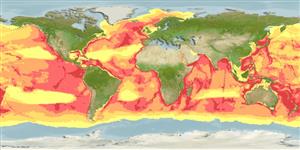Common names from other countries
Environment: milieu / climate zone / depth range / distribution range
Ecologie
Pelagisch; standvastig (Ref. 75906); diepteverspreiding 0 - 1989 m (Ref. 116169). Deep-water; 90°N - 90°S, 180°W - 180°E
Atlantic Ocean and Indo-Pacific. Tropical to warm temperate zones.
Length at first maturity / Size / Gewicht / Leeftijd
Maturity: Lm ?, range 270 - 280 cm Max length : 340 cm TL mannelijk/geslacht niet bekend; (Ref. 1394); Maximaal gepubliceerd gewicht: 400.0 kg (Ref. 1394)
Commonly seen over and near the continental slope. Feeds on deep-water cephalopods, fish and shrimps (Ref. 936).
Tan, J.M.L. 1995. (Ref. 936)
Status op de Rode Lijst van het IUCN (Ref. 130435)
Status bij CITES (Ref. 108899)
Not Evaluated
Gebruik door de mens
Visserij: commercieel
FAO - Visserij: landings, soortsprofiel | FishSource | Sea Around Us
Tools
Meer informatie
Leeftijd/GrootteGroeiLengte-gewicht parametersLengte-lengte parametersMorfologieLarvenAbundantie
Internet-bronnen
Estimates based on models
Preferred temperature
(Ref.
115969): 2 - 13.7, mean 4.5 (based on 2235 cells).
Kwetsbaarheid
Very high vulnerability (90 of 100).
Prijsklasse
Unknown.
